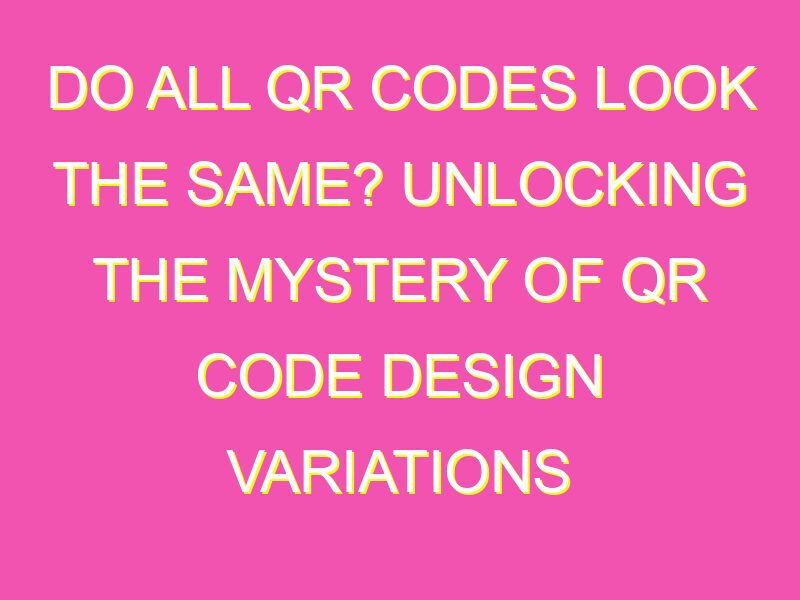Attention tech enthusiasts! Have you ever wondered if all QR codes look the same? Think again! The secret lies in the masks. Here’s a nifty breakdown of mask patterns and what they do to amp up the appearance and functionality of QR codes:
While masks may impact a QR code’s appearance, it is important to note that QR codes containing different information are at no risk of appearing identical. As useful as QR codes are, ensuring that they remain scannable and unique-looking is integral to their success.
Different Masking Patterns Generate Different QR Codes
In today’s technology-driven world, QR codes are seen everywhere – from billboards to product packaging, from restaurants to museums. They are increasingly being used for a variety of purposes, including marketing and promotions. QR codes are graphics that are two-dimensional in nature and use a series of black and white squares to store information data. At first glance, all QR codes may seem the same, but in reality, there are key differences between them.
Understanding Masking Patterns in QR Codes
When generating and printing QR codes, designers have the option to choose from several masking patterns to create a unique design. Masking patterns give different QR codes a distinct visual appearance. However, beyond their aesthetics, the chosen pattern also affects the readability of the code. Masking patterns are algorithms that determine the pattern of the black and white squares that are used to create the QR code. These patterns enable the QR code reader to rapidly access the code’s information. At the same time, they also make the code less susceptible to errors during reading.
Masking Patterns and Their Impact on QR Code Design
When creating QR codes, designers have the option to choose from one of eight masking patterns. However, not all patterns are suitable for every code. Designers must carefully select the appropriate pattern to optimize the code’s readability, which can be impacted due to several factors like printing quality, scanning distance, and reading device type.
Some of the factors that influence the design of a QR code include the purpose of the code, the intended audience and the desired aesthetics. While certain masks appear more visually pleasing, if not used correctly, they can result in an unreadable QR code. This may cause potential consumers to lose interest in the product or service offered by businesses.
In order to optimize the design and functionality of QR codes, it is essential to carefully consider the mask being used.
Exploring QR Code Specifications for Masking Patterns
The International Organization for Standardization (ISO) ascertains the specifications of QR codes. According to their standards, QR codes must have a specific size, error correction level, and a designated format. One of the difference between QR codes that may at first appear the same is the use of different levels of error correction. Error correction helps in preserving data to a certain extent, without which data may be lost or misinterpreted during the scanning process.
Masking patterns, too, are governed by ISO standards. These standards ensure that the mask chosen does not impact the code’s readability. In addition, ISO standards also ensure that the chosen mask produces a unique visual pattern. This eliminates the possibility of duplicate QR codes with identical information.
QR Code Variations Due to Masking Patterns
QR codes that appear identical but have different information stored within them are a common misconception. Every QR code is unique, and any differences in their content will result in an entirely new code with a distinct visual appearance.
As a result, while two QR codes may appear identical to the naked eye, they will produce different results when scanned. Even the slightest variation in the data within the code will alter the pattern, making the new QR code visually unique from its predecessor.
Misconceptions About Identical QR Codes with Different Information
A significant misconception is that the same QR code can be ”renamed” – with different information inserted or replaced without changing the code’s design. This isn’t true as changing any element within a single QR code will create a new, unique QR code. An example of this can be seen in a situation where a company wishes to promote two different coupons via a QR code. They may keep the design of the code identical but use different data linked to respective coupons.
Moreover, QR codes cannot be restored to their original form once edited. Any changes to the code will result in those specific alterations. Hence, designers must ensure they test each QR code thoroughly before it is used for promotion or marketing.
Why QR Codes Cannot Look the Same With Different Information
Even if two QR codes have identical visual appearance, their content will be different from one another. This is because the placement of the black and white squares within the code is unique to represent the specific data encoded within. The content and design elements of a QR code are interdependent, and any change in them affects the other. Furthermore, QR codes are complex systems that utilize intelligent algorithms to store and decode data.
In conclusion, QR codes may appear aesthetically similar, but they are unique in their content, design and functionality. Designers must keep all these aspects in mind when creating and using QR codes for marketing or promotional purposes. It is essential that they understand the underlying specifications and standards of QR codes, including masking patterns, to create codes that are both visually appealing and functional.





